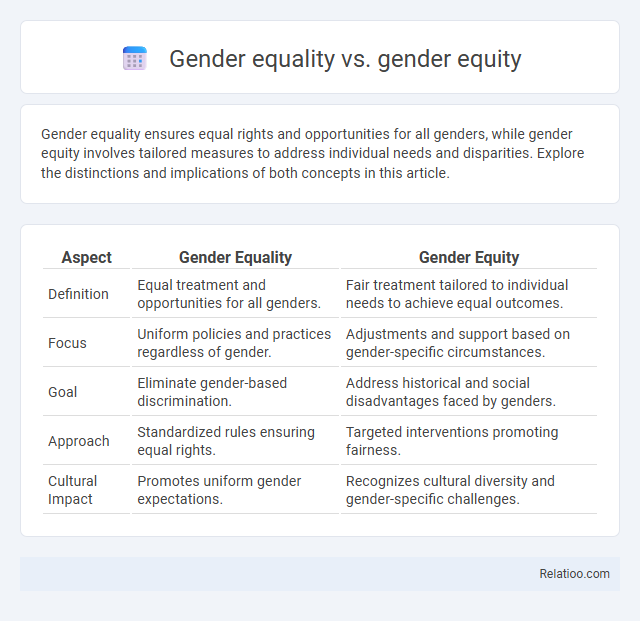Gender equality ensures equal rights and opportunities for all genders, while gender equity involves tailored measures to address individual needs and disparities. Explore the distinctions and implications of both concepts in this article.
Table of Comparison
| Aspect | Gender Equality | Gender Equity |
|---|---|---|
| Definition | Equal treatment and opportunities for all genders. | Fair treatment tailored to individual needs to achieve equal outcomes. |
| Focus | Uniform policies and practices regardless of gender. | Adjustments and support based on gender-specific circumstances. |
| Goal | Eliminate gender-based discrimination. | Address historical and social disadvantages faced by genders. |
| Approach | Standardized rules ensuring equal rights. | Targeted interventions promoting fairness. |
| Cultural Impact | Promotes uniform gender expectations. | Recognizes cultural diversity and gender-specific challenges. |
Defining Gender Equality and Gender Equity
Gender equality refers to the state in which individuals of all genders have equal rights, responsibilities, and opportunities in every aspect of life, including education, employment, and political participation. Gender equity focuses on fairness by acknowledging differing needs and circumstances, providing tailored resources and support to achieve balanced outcomes. While gender equality aims for uniform access and treatment, gender equity addresses structural barriers and inequalities to ensure true fairness and inclusion.
Historical Context of Gender Differences
Historical context reveals that gender equality aims for equal rights and opportunities regardless of sex, while gender equity recognizes the need for fairness by addressing specific disadvantages faced by different genders. Gender role expectations have traditionally reinforced societal norms by assigning distinct behaviors and responsibilities to men and women, often limiting individual potential. Understanding these distinctions helps you dismantle ingrained biases and promotes a more inclusive approach to gender issues over time.
Core Principles: Equality vs. Equity
Gender equality emphasizes providing the same resources and opportunities to all individuals, regardless of gender, ensuring fairness in treatment and rights. Gender equity involves acknowledging different needs and barriers, offering tailored support to achieve comparable outcomes across genders. Gender role expectations, shaped by societal norms, often hinder both equality and equity by imposing predefined behaviors, making it essential to distinguish core principles for effective gender justice.
Examples of Equality in Practice
Gender equality ensures that You receive the same opportunities and rights regardless of gender, such as equal pay for equal work in the corporate sector. Gender equity takes into account different needs and barriers, exemplified by targeted scholarships for women in STEM fields to balance historical disparities. Gender role expectations shape behavior norms, but breaking these can enhance equality, like encouraging boys and girls to pursue any career without stereotypes.
Illustrations of Equity in Action
Gender equality refers to providing the same resources and opportunities to everyone, while gender equity involves recognizing and addressing different needs to achieve fair outcomes, such as offering targeted support to underrepresented genders in STEM fields. Gender role expectations dictate societal norms about behaviors deemed appropriate for different genders, often limiting individual potential. Your understanding of equity in action can be enhanced through examples like flexible workplace policies that accommodate caregiving responsibilities, or scholarship programs designed specifically for women and non-binary students pursuing careers traditionally dominated by men.
Societal Impacts of Gender Inequality
Gender inequality, rooted in rigid gender role expectations, perpetuates systemic disparities in education, employment, and political representation, significantly hindering socio-economic development and social cohesion. Gender equality aims to provide equal opportunities and rights regardless of gender, while gender equity focuses on fairness by addressing specific needs and historical injustices to achieve balanced outcomes. Societal impacts of gender inequality include increased poverty rates, limited access to healthcare and education for marginalized genders, and reinforcement of stereotypes that restrict individual potential and social progress.
Gender Equity in Education and the Workplace
Gender equity in education and the workplace ensures fair treatment, access, and opportunities tailored to individual needs, addressing systemic barriers that hinder underrepresented groups. Unlike gender equality, which promotes identical resources and opportunities, gender equity recognizes that different genders may require distinct support to achieve comparable outcomes. Your commitment to fostering gender equity dismantles gender role expectations that limit potential and drives inclusive environments where everyone can thrive.
Policy Approaches: Equality vs. Equity
Policy approaches to gender equality focus on providing identical resources and opportunities to all genders, aiming for uniform treatment under the law. Gender equity policies prioritize fairness by addressing specific needs and systemic barriers that different genders face, ensuring that outcomes are balanced according to individual circumstances. Your organization can choose between these frameworks to either enforce equal access or tailor support for diverse gender roles and expectations effectively.
Overcoming Challenges to Achieve Gender Fairness
Overcoming challenges to achieve gender fairness requires understanding the distinctions between gender equality, gender equity, and gender role expectations. Gender equality ensures equal access to opportunities and resources for all genders, while gender equity involves allocating resources based on individual needs to achieve fairness; addressing rigid gender role expectations demands dismantling stereotypes and societal norms that limit personal and professional growth. By challenging biases and promoting inclusive policies, you can create an environment where fairness transcends traditional constraints and empowers every individual to thrive.
Fostering an Inclusive Future
Gender equality ensures equal rights and opportunities for all genders, removing barriers that hinder participation in social, economic, and political spheres. Gender equity addresses fairness by providing resources and support tailored to specific needs, recognizing historical and systemic disadvantages. Understanding gender role expectations helps dismantle stereotypes, promoting inclusive environments where diverse identities thrive and contribute to a more equitable society.

Infographic: Gender equality vs Gender equity
 relatioo.com
relatioo.com